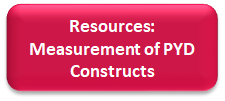Recent Learnings for Measurement of PYD Constructs
What are we measuring?
Though not always obvious, PYD measurement in the context of youth programming needs to take place in at least two ways. Traditionally, the domains of PYD (assets, agency, contribution, and enabling environments) have been measured as perceptions of the individual youth who participate in a program, or youth from communities intended to be influenced by the program. These measures focus on change at the individual level. For instance, did the youth participants gain new knowledge, learn new skills, develop different attitudes or closer relationships with each other and/or trusted adults? Do they feel safer or more confident? Often data are collected using questionnaires, surveys, interviews, and, occasionally, tests, observations, or games. In some cases, information on youth is collected from their teachers or parents rather than, or in addition to, from the youth themselves. To demonstrate program impact tools must be implemented at baseline and at follow-up in order to measure change over time. Therefore, it is important for PYD tools to be valid and reliable with repeated assessments in the local cultural and social context.
Most existing tools assess PYD constructs at the individual level, and not at the policy, agency, system, or community levels. In order to fill this gap, we will need to develop new valid and reliable measures that capture changes in policies, practices, and programing that indicate that youth are in more enabling environments and that agencies, systems, and other organizations have greater capacity to provide and are, in fact, providing PYD programs.
The PYD Learning Agenda provides key questions and sub-questions that need to be answered related to PYD measurement. These are:
- How do we determine whether a measure found to be valid and reliable in one context is appropriate to be adapted to a different context?
- What are the costs and benefits of adapting an existing valid and reliable tool compared to creating a new tool more tailored to the context?
2. How do we best measure the implementation of PYD approaches at the program, system, or agency level?
- What (if any) measures currently exist to evaluate the extent to which a program is PYD vs. not PYD?
- How can we evaluate the impact of efforts to increase the capacity of a system or agency to implement PYD programs and policies?
We have seen progress made in aspects of PYD measurement, and we continue to monitor and report on those advances. These efforts will contribute to increasing the use of valid and reliable measures of PYD constructs and improving the lives of young people in LMICs through better and more cost effective PYD programming.
Aligning Youth Development Theory, Measurement, and Practice Across Cultures and Contexts: Lessons from Use of the Developmental Assets Profile
This paper draws on 50 datasets from 31 countries, involving more than 25,000 young people, ages 9-31, to more comprehensively describe the strengths and issues involved in using the Developmental Assets Profile (DAP) for measurement of child well-being across cultures and language groups.
Brief Report: Assessing youth well-being in global emergency settings: Early results from the Emergency Developmental Assets Profile
This paper presents the results of tests in 15 countries of the 13-item Emergency Developmental Assets Profile to measure the well-being of children and youth in emergency settings such as refugee camps and armed conflict zones.
Measuring Spirituality, Hope, and Thriving Among Salvadoran Youth: Initial Findings from the Compassion International Study of Positive Youth Development
This assessment of Compassion International’s PYD approach tests their PYD measures. Youth involved in the program showed higher levels of spirituality and character, compared to youth not in the program.
Positive Youth Development and Relational-Developmental Systems
This book chapter describes the construction of the concept of positive youth development.
Creation of the Short and Very Short Measures of the Five Cs of Positive Youth Development
Using a series of exploratory factor analyses and CFA models, this research creates short and very short versions of the scale used to measure the Five Cs of PYD in the 4-H Study of Positive Youth Development.
Youth Programming Assessment Tool: Ensuring High-Quality Youth Programming and Institutionalizing Positive Youth Development
This webinar introduced the Youth Programming Assessment Tool (YPAT), which provides youth-serving organizations with concrete steps and examples for how to improve their programming based on the PYD approach.
Soft Skills for Cross-Sectoral Outcomes Assessment: Administration Guide
The YouthPower Action Soft Skills Assessment serves as a validated measure of key skills for youth development outcomes, such as family planning and reproductive health, violence prevention, and success in the workforce. The purpose of this resource is to guide the administration of the YouthPower Action soft skills tool.
Measuring Soft Skills Among Youth and Young Adults: Validation of a New Instrument
The YouthPower Action Youth Soft Skills Assessment is a measurement tool for youth soft skills, developed and validated for administration with youth in lower-resource environments. The target group for the measurement tool is youth aged 15-19 years, both in and out-of-school, who are typically the beneficiaries of USAID-sponsored youth programs.
Youth Family Planning Policy Scorecard: Measuring Commitment to Effective Policy and Program Interventions
This report presents the Youth Family Planning Policy Scorecard to promote uptake of contraceptive methods among youth. The scorecard can be used to evaluate a country’s youth FP policy environment, set policy priorities and guide future commitments, and compare policy environments across countries.
Youth Programming Assessment Tool
This tool provides youth-serving organizations with concrete steps and examples for how to improve their programming based on the Positive Youth Development (PYD) approach.
What Gets Measured Matters: A Methods Note for Measuring Women and Girls’ Empowerment
The purpose of this Methods Note is to provide practical guidance on how to integrate measures of empowerment into investments that strive to achieve gender equality and women and girls’ empowerment.Gets Measured Matters. A Methods Note for Measuring Women and Girls’ Empowerment.
Key Soft Skills for Cross-Sectoral Youth Outcomes
This paper seeks to identify which soft skills enjoy the most support for predicting positive outcomes for youth across the three fields of workforce development, violence prevention, and SRH, and thus, should be cultivated as part of strategies to create those positive outcomes. Skills that emerge as enjoying the most support across sectors are recommended as targets for youth development programming employing a common skills approach.
Measuring Soft Skills & Life Skills in International Youth Development Programs: A Review and Inventory of Tools
This report provides general findings from a review and inventory of tools that measure cross-cutting skills, based on key criteria for use by international youth development programs. The report concludes with recommendations for improving the state of soft skill measurement resources.
Guiding Principles for Building Soft Skills among Adolescents and Young Adults
This report contains findings from a review of literature reviews and meta-analyses as well as general guides on how to develop soft skills. Specific examples of effective practice applying each principle, drawing from international and U.S. youth programs across the fields of workforce development, violence prevention, and sexual and reproductive health are provided.
Measurement of Social Norms Affecting Modern Contraceptive Use: A Literature Review
The goal of this literature review was to identify and evaluate social norm measures related to modern contraceptive use.
What Are Social Norms? How Are They Measured?
This report offers an account of what social norms and other social practices are, with special attention to child well‐being, and especially child protection. It also outlines a number of measurement strategies to identify social norms and measure their change over time.
Assessing youth well-being in global emergency settings: Early results from the Emergency Developmental Assets Profile
The Emergency Developmental Assets Profile measures the well-being of children and youth in emergency settings, assessing whether young people are experiencing adequate positive relationships and opportunities, and developing positive values, skills, and self-perceptions, despite being in crisis circumstances. (2015)
Measuring Spirituality, Hope, and Thriving Among Salvadoran Youth: Initial Findings from the Compassion International Study of Positive Youth Development
The findings indicate promising first step in understanding the potential role of strengths-based youth development programs in promoting the thriving of youth living in poor ecological settings.











